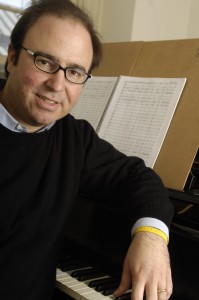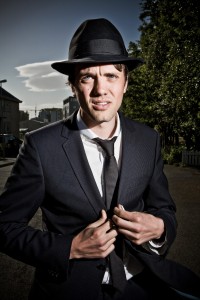
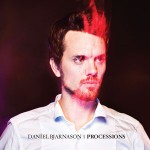 I talked with Bjarnason on the phone Monday night after a rehearsal in NYC for his upcoming Le poisson rouge concert and his new release, Processions:
I talked with Bjarnason on the phone Monday night after a rehearsal in NYC for his upcoming Le poisson rouge concert and his new release, Processions:
MP3 file of our interview, part 1
MP3 file of our interview, part 2
Catch Bjarnason at LPR tomorrow (Wednesday night) in NYC at 7pm.
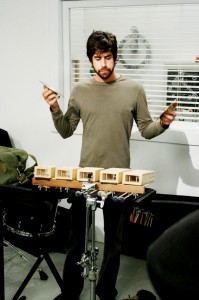
(UNTITLED), an original film satire of New York’s avant-garde art scene, will appear in theaters across the nation this fall. By poking fun at the idiosyncrasies of 21st century Bohemia, (UNTITLED) introduces American audiences to some of the best that contemporary art has to offer, notably a score by Pulitzer Prize-winning composer David Lang, who merges the artistic expressions of the composer protagonist with his own musical voice.
(UNTITLED) revolves around melancholy composer Adrian (Adam Goldberg) and his whirlwind affair with a Chelsea gallerist (Marley Shelton), who unbeknownst to Adrian sells vacuous commercial works to high-paying corporate clients. The film explores the idea of true art and the question of integrity lost through commercialism – all with tongue in cheek. At the beginning, Adrian’s music comprises cliché contemporary classical music elements, such as crinkling paper and breaking glass. Once his perspective and emotions achieve depth and insight through his blossoming romance, his music becomes more profound.
John Clare had a chance to send questions to both David Lang and Adam Goldberg. In the second part (part 1 is here with David Lang), John Clare finds out more about (UNTITLED) from its star, Adam Goldberg.
1. Often with a joke, there is some seriousness or truth behind it. Is there some truth to this movie even though there is some fun being poked?
Well, actually upon my last viewing of it, the second time I watched it with an audience, albeit at LACMA–the perfect audience–it seemed to have a real weight to it. The film sort of takes a turn once the absurdity is established I think. For me the film really has always been about this righteous indignation, this sort of defensiveness of one’s position–whether as an artist or a audience member or a critic or an art dealer, in this case–that really is front for enormous insecurity. These characters are all wayward and tend to overcompensate with very stringent , often absurd, points of view.
2. There are some outrageous sounds and art. How does your taste run in real life – in both “new concert music” and “art”?
I definitely have always been obsessed with sound and strange sounds and repetition, but usually incorporated into something melodic or hypnotic in some way. I have for a long time been a fan of Steve Reich–whose work began with simple tape loops and phasing of found material, but eventually he applied this process to beautiful symphonic pieces. I have also been a fan of some conceptual art, but usually when it engages the viewer, interacts with him or her in some way or tells a story. I don’t like things that seem to aim merely to shock or to alienate. Basically if it moves me or I can relate to it in some way then, well, I like it.
3. David Lang is a Pulitzer Prize winner and incredibly gifted composer, but unfortunately not a household name – how was he chosen for the movie, and how was collaboration with Untitled?
I believe Jonathan, the director, knew David from music school. He had an interesting job, both to score the film and create the ‘sound’ pieces our little group performs–though in the end it was so bizarrely structured and arranged that we could often only barely perform to playback so much of the “music” we’re making we actually are making. David also served I think as a bit of a consultant to Jonathan when he was writing this, creating my character. I love David’s music and this score is quite beautiful I think.
4. What is the possibility of Untitled 2, or Untitled – the Showtime series?
Ha!
5. There have been quite a few composers in pop culture these days, from “Forgetting Sarah Marshall” (Jason Segal) to “Mr. Magorium’s Wonder Emporium” (Natalie Portman’s piano/composer) and the likes of Paul McCartney & Billy Joel writing new classical music. Is composition a new cool as nerds (think Big Bang Theory) are?
Hmmm….I’ve never thought “Big Bang Theory.” Well, I remember years ago Elvis Costello put out a sort of classical record with the Brodsky Quartet that was pretty innovative. Conversely, Philip Glass many many years ago started I think to incorporate a sort of popular music element–singing an so forth–into his music. I think there’s always been some overlap. I saw a great piece that a childhood friend of my girlfriend’s put on. Michael Einziger from Incubus of all things. It was fantastic, sort of Reich meets Bernard Hermann. I think there’s something that feels for lack of a better word “legitimate” about working with classical elements. I know that some of the stuff musically I’ve done musically, with my project LANDy, that I’ve been most proud of incorporates some classical elements–arrangements of strings and that sort of thing. Albeit I’m usually humming the arrangements like a crazy person to the poor violinists.
(UNTITLED) opens tomorrow, October 23rd, in a limited release; and the soundtrack is out already from Cantaloupe!

 (UNTITLED), an original film satire of New York’s avant-garde art scene, will appear in theaters across the nation this fall. By poking fun at the idiosyncrasies of 21st century Bohemia, (UNTITLED) introduces American audiences to some of the best that contemporary art has to offer, notably a score by Pulitzer Prize-winning composer David Lang, who merges the artistic expressions of the composer protagonist with his own musical voice.
(UNTITLED), an original film satire of New York’s avant-garde art scene, will appear in theaters across the nation this fall. By poking fun at the idiosyncrasies of 21st century Bohemia, (UNTITLED) introduces American audiences to some of the best that contemporary art has to offer, notably a score by Pulitzer Prize-winning composer David Lang, who merges the artistic expressions of the composer protagonist with his own musical voice.
(UNTITLED) revolves around melancholy composer Adrian (Adam Goldberg) and his whirlwind affair with a Chelsea gallerist (Marley Shelton), who unbeknownst to Adrian sells vacuous commercial works to high-paying corporate clients. The film explores the idea of true art and the question of integrity lost through commercialism – all with tongue in cheek. At the beginning, Adrian’s music comprises cliché contemporary classical music elements, such as crinkling paper and breaking glass. Once his perspective and emotions achieve depth and insight through his blossoming romance, his music becomes more profound.
John Clare had a chance to send questions to both David Lang and Adam Goldberg. In the first post, here are Lang’s answers about (UNTITLED):
1. Often with a joke, there is some seriousness or truth behind it. Is there some truth to this movie even though there is some fun being poked?
There is a lot of truth in this movie, mostly about how people in the arts become passionately committed to something they believe in that may look unbelievable from the outside. I think that creative commitment is captured very well, as is the distance between the committed people and the people watching the committed people.
2. How cool is it for the composer to “get the girl” in this movie? Did it influence your music for the film?
Getting the girl didn’t influence my thinking in the movie, although it didn’t hurt. The progression of the character musically is that he begins by making music only for himself, because that is how large his world view is; when he meets the girl his senses and optimism and maybe even his idea of audience expand, and his music changes accordingly. I definitely tried to make that shift happen in the music. (more…)
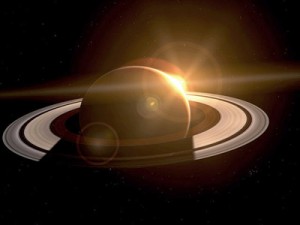
So I was amused to find this as I was checking news this morning:
(CNN) — Scientists at NASA have discovered a nearly invisible ring around Saturn — one so large that it would take 1 billion Earths to fill it. Its diameter is equivalent to 300 Saturns lined up side to side. And its entire volume can hold one billion Earths, NASA Jet Propulsion Laboratory said late Tuesday. The obvious question: Why did it take scientists so long to discover something so massive?
The ring is made up of ice and dust particles that are so far apart that “if you were to stand in the ring, you wouldn’t even know it,” Verbiscer said in a statement. Also, Saturn doesn’t receive a lot of sunlight, and the rings don’t reflect much visible light. But the cool dust — about 80 Kelvin (minus 316 degrees Fahrenheit) — glows with thermal radiation. NASA’s Spitzer Space Telescope, used to spot the ring, picked up on the heat.
Coincidence? Maybe not. And of course, Zaimont has a charming piano suite “Callisto” based on the moons of Jupiter, as well as other astral works: ASTRAL… a mirror life on the astral plane…; Sky Curtains: Borealis, Australis; and Chroma: Northern Lights. Look for video of the new concerto in an upcoming Composing Thoughts.
Here are the program notes supplied by Zaimont about the new concerto:
I. Outward Bound (10:00)
II. Nocturne (Lunar) (8:40)
III. Ad astra per aspera (6:50)
Concerto “Solar Traveller” is absolute music, following no implicit program. Yet the work and its individual movements carry descriptive titles rather than the more traditional tempo markings. This is because the Concerto is one of several of my works drawing inspiration from the impress upon our consciousness and imagination of the vastness, wonder and beauty of the natural world of sky, season and space. These pieces (all instrumental works) share a dramatic and coloristic emphasis, and their forms are far from traditional. (This inspirational thread began with the twelve solo-piano preludes of A Calendar Set, and continues in similar works, including the orchestral Chroma – Northern Lights and the piano trio ZONES.)
While the Concerto outwardly observes the usual three-movement large form, its individual movements digress in key ways from an orthodox ‘concerto’ template. “Outward Bound” contrasts two themes, one heroic, energetic and the second inward and moody. The motive-filled first theme is announced by the piano and soon becomes a communal statement for soloist and ensemble. When the second theme enters, it too is stated by the piano alone and it remains predominantly soloist’s terrain throughout. Extensive development centers on extrapolations of the heroic theme; to balance, the cadenza is devoted entirely to the second theme. The movement concludes heroically .
“Nocturne (Lunar)” is the soloist’s terrain, punctuated and frequently partnered by the ensemble in music largely expansive, as if in ‘stopped’ time. As it proceeds a tune arises (heard first as a flute solo above quiet piano accompaniment), fashioned from the simplest of materials; each of the tune’s appearances anchors the movement, calming the mercurial, fragmentary outbursts from the piano. At times as desolate and unfamiliar as a lunar landscape, the nocturne eventually calms, concluding serenely.
A driving sprint, “Ad astra per aspera” grows from an insistent rhythmic cell freshened by hemiolas and other cross-rhythms and chromatic clashes. Percussion is spotlighted throughout, and the soloist shifts frequently from foreground to combining with the ensemble — a change of function which in itself becomes textural counterpoint to the forward thrust. A brief respite (trumpet solo) occurs during which the incessant beating disappears, but the essential rhythm returns shortly in full force. Towards the end the Nocturne’s theme enters in the ensemble, in overlapping meter with the soloist, who continues the main drive; just prior to the vehement close a fragment of the heroic first movement is again heard.
The work ties together through a technical feature: Each movement is built from the raw material of a progressively smaller interval.
Outward Bound’s themes are built from 3rds and all of the development highlights that consonant interval. (At one point there is a scale upwards across two-thirds of the keyboard in parallel thirds, played entirely by the left hand). Built from 2nds, the Nocturne achieves its uneasy, fragmentary quality from the clash of 2nds hammered loudly or (stretched to 7ths and 9ths) in glittering scherzo filigree. “To the stars, through adversity” is formed by ultimate compression: pounding unisons. Thus, the Solar Traveller pianist physically experiences the compressive forces and increased tensions we associate with space travel’s incredible speeds, through the analog of progressive intervallic compression throughout the piece.
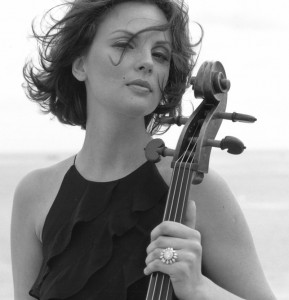 Nina Kotova premieres a new work by Christopher Theofanidis this weekend in Dallas. In the second part of looking at the new work, I spoke with the soloist about the piece, and learned more about how the piece came into being. Listen to our conversation:
Nina Kotova premieres a new work by Christopher Theofanidis this weekend in Dallas. In the second part of looking at the new work, I spoke with the soloist about the piece, and learned more about how the piece came into being. Listen to our conversation:
mp3 file
The concert takes place Thursday, Friday & Saturday – and more performances coming up in Asia & Europe.
This week, the Dallas Symphony premieres a new concerto written for cellist Nina Kotova. Christopher Theofanidis is teaching at Yale and about to embark on two new operas for Houston and San Francisco. He took some time out last week to let me know more about the work and what he’s been up to!
Listen to the conversation:
mp3 file
Tomorrow, a post with the soloist, who also composes…
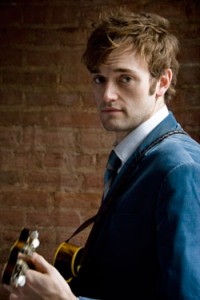
Labor Day 2009 and while John Clare has an airshift, he also has an interview. Chris Thile is relaxing in New York and making coffee, ready to talk shop. Thile jokes, waxes poetic and has a thoughtful answer for the questions. You see, Chris is about to add to the small repertoire of mandolin & orchestra concertos, with his own Ad astra per alas porci. The world premiere performances are September 17, 19, and 20, 2009 with The Colorado Symphony & Jeffrey Kahane.
In the second part of our interview Chris talks about how the piece came about and if others might perform it: Interview Part 2
Thile has been busy as well with his band, The Punch Brothers, and with a duo project with bassist extraordinaire Edgar Meyer. He’ll keep up the concerto as well, with six more chances for you to hear it, the Oregon Symphony (September 26, 2009; with Carlos Kalmar), the Alabama Symphony (October 29, 2009; with Justin Brown), the Los Angeles Chamber Orchestra (January 23 and 24, 2010; again with Jeffrey Kahane), the Winston-Salem Symphony (March 13, 14, and 16, 2010; with Robert Moody); the Delaware Symphony (March 19 and 20, 2010; with David Amado);and the Portland Symphony (March 28, 2010; with Scott Terrell).
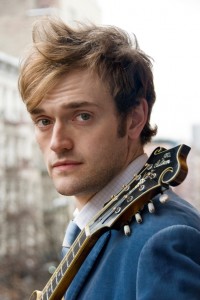 It doesn’t seem all that long ago that I heard the world premiere of Blind Leaving the Blind. (Read about it here: S21 Review.) It was quite a night @ Zankel, St. Patrick’s Day 2007. Chris Thile has since recorded the work with the Punch Brothers, and made a duo album with Edgar Meyer. Now Thile is about to embark on another journey – a mandolin concerto, Ad astra per alas porci.
It doesn’t seem all that long ago that I heard the world premiere of Blind Leaving the Blind. (Read about it here: S21 Review.) It was quite a night @ Zankel, St. Patrick’s Day 2007. Chris Thile has since recorded the work with the Punch Brothers, and made a duo album with Edgar Meyer. Now Thile is about to embark on another journey – a mandolin concerto, Ad astra per alas porci.
This week he plays with The Colorado Symphony (September 17, 19, and 20, 2009; with Jeffrey Kahane), then six more chances to hear it, with the Oregon Symphony (September 26, 2009; with Carlos Kalmar), the Alabama Symphony (October 29, 2009; with Justin Brown), the Los Angeles Chamber Orchestra (January 23 and 24, 2010; again with Jeffrey Kahane), the Winston-Salem Symphony (March 13, 14, and 16, 2010; with Robert Moody); the Delaware Symphony (March 19 and 20, 2010; with David Amado);and the Portland Symphony (March 28, 2010; with Scott Terrell).
I talked with Thile about the new work, enjoy the first part of our discussion, including using amplification or not, and about his Steinbeck title: Interview Part 1
More tomorrow, including how the piece came about and if others might perform it!

Hahn. Hilary Hahn. The violin superstar is about to premiere a new work by Jennifer Higdon tomorrow (Friday) night, attend the Grammy Awards this Sunday with two chances to win for Best Classical Album and Best Instrumental Performance with Orchestra, and then go on a recital tour playing Ives and Ysaye. She took out a few minutes to talk about the new piece and about the Grammys.
Part 1 (having a piece tailor made for her)
Part 2 (attending the Grammy Awards)
She has also just updated her YouTube Channel with Schoenberg’s grandson Randy:
[youtube]http://www.youtube.com/watch?v=gjW4aDQa0Vg[/youtube]
She mentioned that she’ll interview Higdon on her website, will perform at the Grammy Awards preshow and can be seen online, and if you haven’t seen it, her violin case twitters!
